Ever since the Vitória Stone Fair began taking place in the stoneworking region of Vitória, Brazil, in 2002, the show’s growth and energy has mirrored the explosive growth of Brazil’s stone industry. This past edition, however, took place at a time when the nation’s industry is facing its first real challenges since becoming a major player in the international stone industry. Because Brazil relies heavily on the U.S. as an importer of its finished stone products - particularly granite slabs - the downturn in the U.S. housing market has had a noticeable impact on the Brazilian stone industry.
Looking at the statistics, exports of granite from Brazil to the U.S. actually grew from a value of $538.24 million in 2006 to $555.05 million in 2007, but looking at those numbers alone can be very deceiving. During the early part of 2007, Brazilian granite exports to the U.S. were far greater than the previous year - up as much as 25% in some months. But the declines of late 2007 resulted in total growth of only 3% for the year, and no one is expecting an increase for 2008.
So with this in mind, I was curious to see the attitude of the stone suppliers I would meet in Brazil. For the most part, their mindset was one of resolve. Many of these companies had never been through this before, but most of them seemed to be up to the challenge. They are aware of the decline in business, as well as the factors that go beyond the U.S. housing market downturn. Specifically, I am talking about new and expanded factories in Brazil that have increased competition among suppliers and the devaluation of the U.S. dollar.
These topics were on the minds of most Brazilians I spoke with while in Vitória, and many of these people are devising company strategies to deal with this new economic climate. As one stoneworking professional explained to me, “This [downturn] will help us to look at our way of doing business, and see how it can improve. And when the crisis is over, those strategies will still be in place.” (I’ve had several U.S. fabricators outline a similar business strategy, and it makes good sense to me.)
Many of the leading Brazilian companies have made the decision to face these new challenges head on, aggressively marketing their products to the U.S. market and emphasizing the quality and variety of their production. They are present at trade shows such as Coverings and in print publications such as Stone World. And, of course, salespeople from these companies are hitting the highways throughout the U.S., visiting with their clients face to face on long business trips that often take them to three or four different regions of the country in one journey.
Beginning on page 96 of this issue, Stone World will be presenting the first part of its Report from Brazil, focusing on the products that were on display at the Vitória Stone Fair and some stoneworking operations throughout the state of Espírito Santo. Next month, our Report from Brazil continues with a report on the stoneworking operations and exotic quarries in the state of Ceará, which lies in the northern part of the nation.
I traveled to Brazil twice over the past few months - once for each portion of our report - and I can tell you first-hand that the spirit of these stoneworking professionals is alive and well.
Of course, for all the resolve and spirit, the downturn being felt by Brazilian stone suppliers can be grating at times (just as it is for American stone fabricators). Before I left the Vitória Stone Fair, I went back to the supplier that I quoted earlier in this column, and complimented her for her resolve and determination. Her response summed up the feelings of many stone-related companies these days: “Thanks. It’s great to have a strategy. Of course, it would be nice to sell some containers, too.”
Brazil digs in
